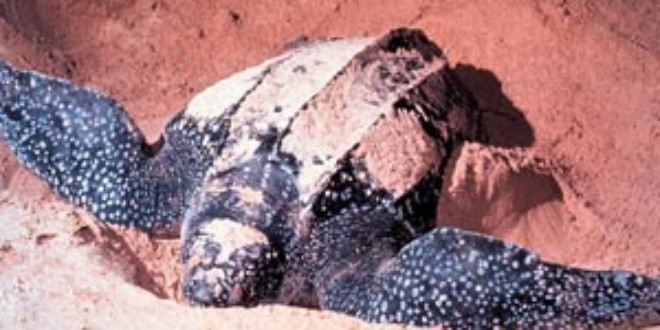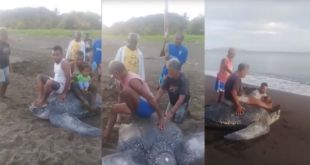Feasting on their eggs, taking them as pets, stuffing them for souvenirs and pulling apart their shells to make combs and bags – these are just a few in a long list of threats that have left turtles at their most precarious in living memory. Leatherback Turtles have been declared functionally extinct in many areas where they were once common. Some populations in the Indo Pacific region crashed by over 90 per cent over the past two decades.
Many other marine turtles are heading down the same path.
Asian Box Turtles, popular for their meat and as medicine, are vanishing across much of Malaysia and other parts of their range.
The threats to turtles in Malaysia are many as evidenced by the 814 turtles that Customs officers rescued from traffickers last month, just as they were about to be smuggled across the northern border.
Though illegal in many states here, marine turtle eggs are still openly available in a number of markets in the country some sourced from waters off Sabah and others from the Philippines and Indonesia, as numerous seizures have shown.
Last November, Malaysian marine police seized 10,000 marine turtle eggs near Sandakan. They were smuggled in from the Philippines.
But the demand and cross border trade in turtles in this region poses as much of problem, shows a new report by wildlife trade monitoring network TRAFFIC.
The study on the marine turtle trade in Vietnam reveals how traders in there are reporting that they get their supply of raw scutes – the individual segments of the turtle shells – from Malaysia and Indonesia.
The populations of numerous species are also falling due to the international pet trade with a taste for the beautifully patterned species.
{youtubejw}fAB9_0BRoR8{/youtubejw}
TROUBLED TURTLES
Many turtles are headed fast towards trouble. Here are five examples:
1 Marine Turtles
Top on the troubled turtle list is the Leatherback Turtle. This heavyweight champion of the reptile world, Leatherback Turtles can tip the scales at over 900kg.
Individuals cover 10,000km distances over time and they can dive more than one kilometre deep.
The only species of this family lives in the open ocean, and feeds almost entirely on jellyfish. Although females may lay up to 160 eggs per clutch, threats imposed by human behaviour are diminishing world populations.
Nesting beaches are under severe threat from development, while pollution and poaching add to current threats.
The World Conservation Union’s (IUCN) Red List of Threatened Species classifies the Leatherback as critically endangered, and although some viable populations are recognized, those in West Malaysia are teetering on the brink of extinction.
Other marine turtles like the Hawksbill and Green Turtles are also imperilled.
In March last year Sabah marine police seized 72 Green and Hawksbill Turtles in one raid and three days later, another batch of 220 of these two species in Chinese fishing boats.
2 River Terrapin Batagur baska
The River Terrapin is one of few turtles that live in rivers and then go into brackish water and lay their eggs on beaches.
Their homes are under ever increasing pressure from the impacts of development. Egg exploitation and poaching have also contributed to the decline.
The IUCN’s Red List of Threatened Species lists it as extinct in Thailand, Myanmar and Vietnam. It is endangered in Peninsular Malaysia and Indonesia, and critically endangered in India and Bangladesh.
3 Impressed Tortoise Manouria impressa
This tortoise can be found in hilly forests of continental Southeast Asia. Like all tortoises and many other terrestrial turtle species, females of this species only lay eggs after several years and rarely more than 15 eggs at a time.
The species has a unique and beautiful back golden shell with impressed scutes, which may be the reason why it is collected and transported worldwide for the international pet trade.
Many do not survive. But this species is also sought after in Asian food trade; the back shell is sold as trophies while the belly shell is used in traditional Chinese medicines.
It is classified as vulnerable on the IUCN Red List.
4 Southeast Asian Box Turtle Cuora amboinensis
A once widely distributed turtle living in diverse wetlands in Southeast Asia, this species has now become rare in many parts of its range.
The young usually do not leave the water but the adults can be found travelling on land.
What makes box turtles unique is their flexible hinge on the belly shell (plastron), which locks all soft body parts when threatened. This means the turtle can withdraw its entire body into its shell.
The intense demand in the shell for traditional Chinese medicines and soft body parts for the Asian food market has caused a decline to many populations in its range.
Recently published studies by TRAFFIC Southeast Asia show that this species is being traded at 10 to 100 times the legal levels in Indonesia and is being overexploited in Malaysia despite a ban on its trade here.
The IUCN Red List classifies it as vulnerable.
5 Asian Giant Softshell Turtle Pelochelys cantorii
The Asian Giant Softshell Turtle is one member of four species of softshell turtles native to Malaysia, besides many tropical Asian countries, where it is found in large rivers and estuaries.
Until today the biology of the species still remains poorly understood, as is true for many threatened turtles and tortoises of Malaysia.
Unlike other freshwater turtles, softshell turtles have a leathery “shell” which is very flexible at its rear end. This species is much more flat in shape than its close relatives, and its snout projects in a very small trunk.
It is also one of world’s largest aquatic non-marine turtles, measuring approximately 1.5m and weighing 200kg.
Over much of its range populations have been severely depleted, largely due to poaching and destruction of habitats. The World Conservation Union’s Red List of Endangered Species lists it as endangered.
WHAT YOU CAN DO TO REVERSE THE TIDE
1. Don’t buy or eat turtle eggs
Turtles lay a large clutch of eggs to help ensure survival of the species as many hatchlings are taken by predators at sea.
Taking the eggs for human consumption further compounds the problem.
2. Don’t buy souvenirs made from turtle parts
Turtle and tortoise shells are often removed in a very cruel manner, in many cases while the animal is still alive. All marine turtles and many freshwater turtles and tortoises are protected under various national laws.
All marine turtles and tortoises as well as some freshwater turtles are listed in CITES (Convention on International Trade in Endangered Species of Wild Fauna and Flora).
Buying freshwater turtles and tortoises and marine turtles or their parts and derivatives may be illegal.
3. Support a turtle rescue programme/Adopt a turtle
For further information, visit: www.asianturtlenetwork.org, http://www.umt.edu.my/turtle/ or www.iucn-tftsg.org.
4. Learn about turtles and make your voice heard: www.traffic.org, www.wwf.org.my
5. Report illegal trade to authorities.
(From nst.com.my, Malaysia, by Elizabeth John)
 Ocean Sentry
Ocean Sentry




